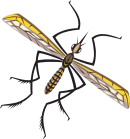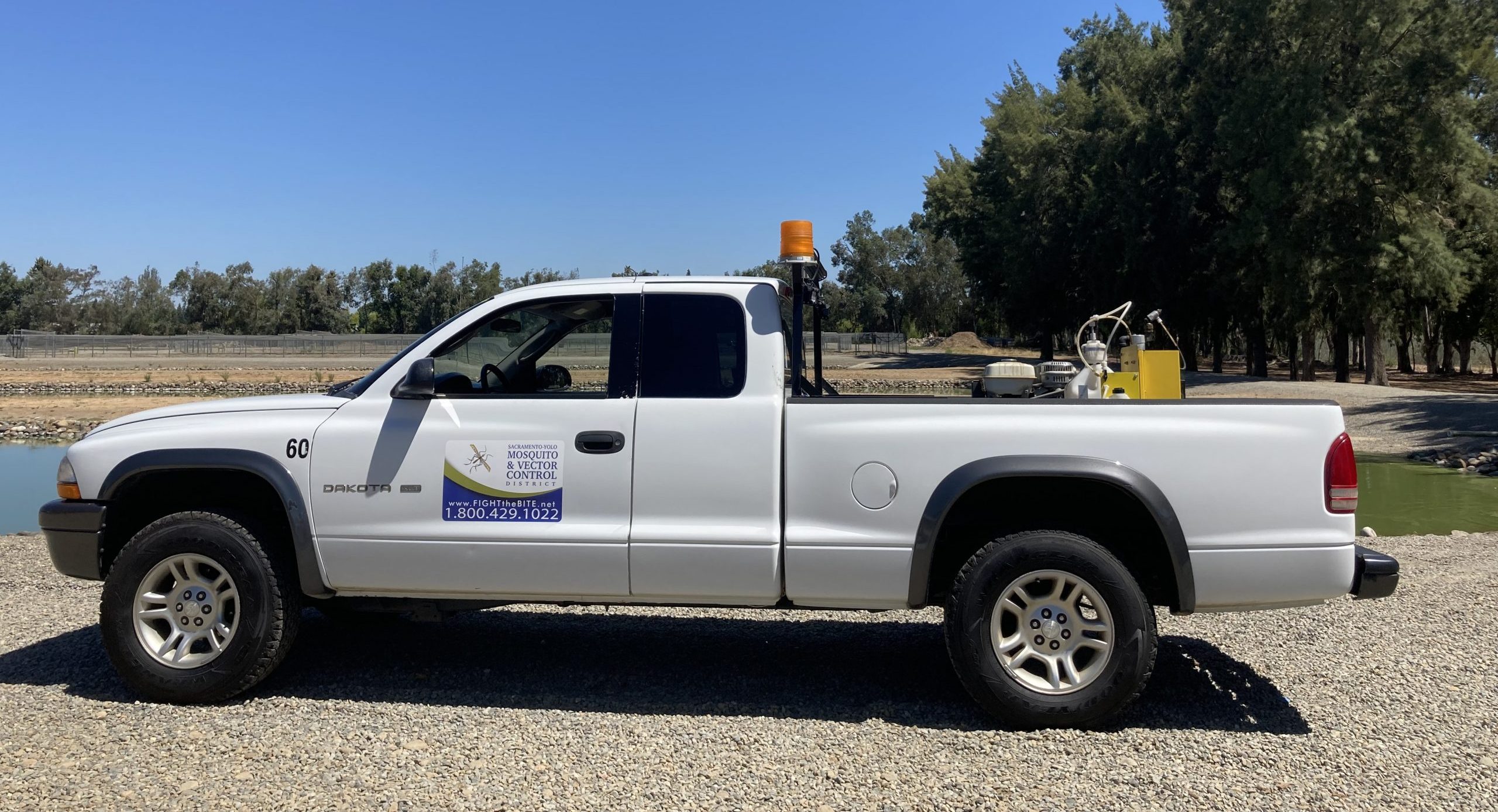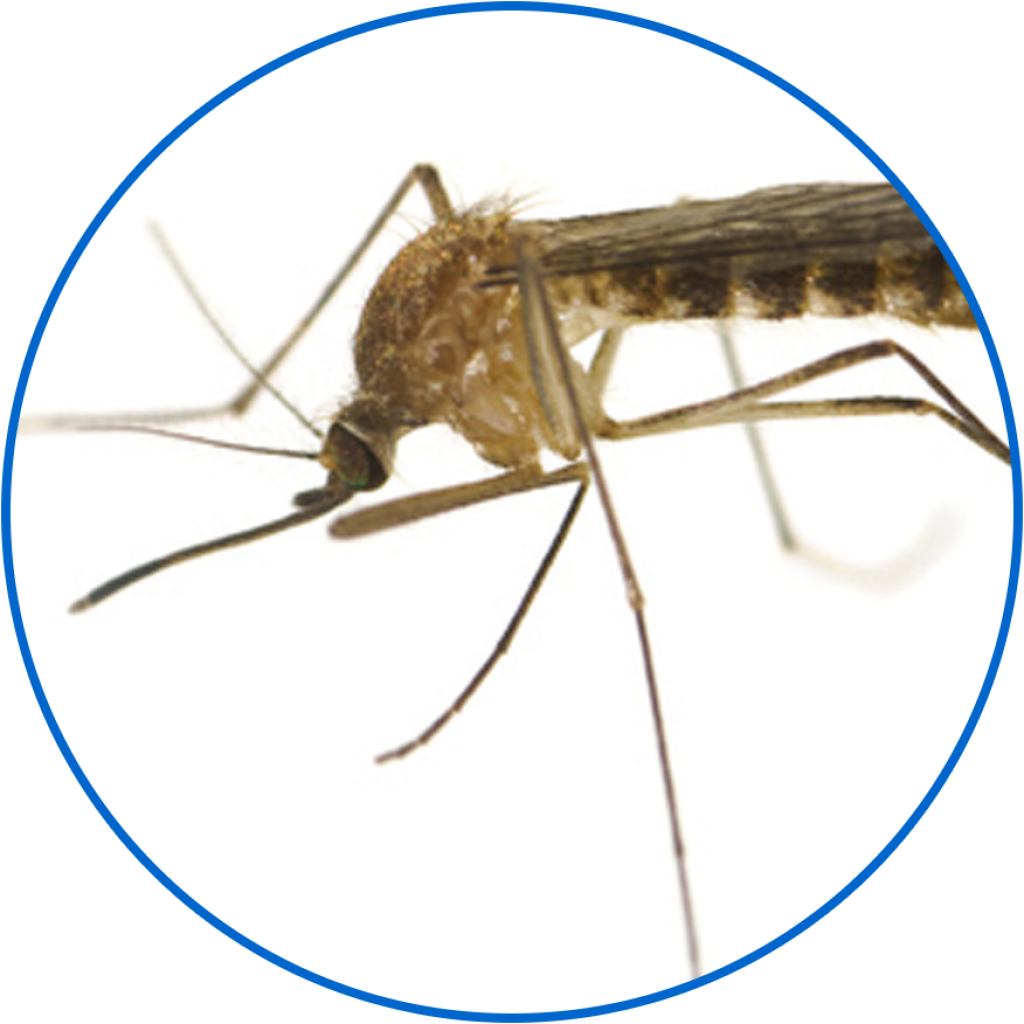SPRAYING FREQUENTLY ASKED QUESTIONS
A. The District may conduct adult control treatments based on the finding of high mosquito abundance or West Nile virus activity in a specific area. These treatments are conducted by applying insecticides as an ultra-low-volume (ULV) spray that produces very fine aerosol droplets into the air that affects mosquitoes on contact. When West Nile virus positive mosquito populations are identified, an adult control treatment will reduce the number of adult infected mosquitoes decreasing the risk of disease transmission to the public. Adult control treatments can be conducted using ground or aerial based equipment. To view a current map of the West Nile virus activity throughout Sacramento and Yolo counties, CLICK HERE.
A. At the rates we apply these products (3/4 oz or less per acre), they should not pose a significant risk to you or your family. These materials have been used extensively and successfully throughout the country for decades. However, it is always a good idea to remain indoors and keep windows and doors closed during applications. For more information on insecticides and health, consult the U.S. Environmental Protection Agency, which oversees the registration of these chemicals. The National Pesticide Information Center (NPIC) can also provide information through a toll-free number, 1-800-858-7378 or online.
For treatment schedule including locations see our Spraying Update page.
A. The material used will be Naled. It is sold under the name Dibrom, is an insecticide that has been registered by the U.S Environmental Protection Agency (EPA) since 1959 for use in the United States.
It is used primarily for controlling adult mosquitoes, but can also be used to control other insects.
A. In mosquito control programs, Dibrom is commonly applied as an ultra-low volume (ULV) spray by aircraft-mounted spray systems.
ULV sprayers dispense very fine aerosol droplets that stay aloft and kill mosquitoes on contact.
ULV applications involve small quantities of the pesticide in relation to the size of the area to be treated. For mosquito control purposes, we use 0.6 ounces per acre treated, which is roughly the size of a football field. In particular. Naled degrades extremely rapidly on surfaces, and therefore residues decline to a level that does not pose any potential concern.
A.If used properly in accordance with the label, Dibrom is not harmful to pets, fish, birds, or livestock. Residents may elect to bring pets indoors or cover fishponds during spraying events to minimize exposure.
A.Although no specific precautions are required during an application, individuals with known chemical sensitivities or a heightened sense of concern should:
1. Contact their local mosquito control program to get specific information on spraying in their area.
2. Stay indoors with the windows closed during the time of the application.
A. The reason you hear or see the plane flying above your home even though you are not in the spray block is because in order to get the material into a desired area they may fly just outside of it. Based on current weather conditions measured by on board plane equipment, there is an offset from where the material is being sprayed to the target area. The wind will then carry the material into the specific spray block. The planes are equipped with a sophisticated weather system that clearly show wind speed, direction, humidity and temperature. Pilots use this information to help get the materials in the areas that need to be sprayed and ensure successful applications. While the planes may be flying directly above your home, the material is not being deposited there.
A. If you have a window air conditioning unit, you can turn off the vent so that air is not brought in from the outside. Central air conditioning units cool recirculated air in your house. Since a central air conditioning unit does not pull in outside air, there is no need to turn it off.
A. The materials used for controlling mosquitoes used in accordance to the label are not harmful to animals. Many times it is same materials used to treat cats and dogs for fleas and ticks. However if you want to reduce your pet’s exposure, keep them inside during spraying.
A. Our application methods minimize impacts to insects like bees and butterflies because treatments are made during times of the day when they are not actively foraging and are protected by their hives or resting areas. Also, the dosages/droplet sizes are designed specifically for tiny insects like mosquitoes; much higher dosages would be required to cause significant harm to bees or butterflies which have many times the body mass of a mosquito. We do not apply products to blooming crops or weeds. Finally, mosquito control districts have used EPA registered public health pesticides for decades with insignificant evidence of harm to these insects.
A. Your swimming pool water and items found in your yard should not be affected. Applications are made in the very early morning hours or late evening hours, and the materials we use break down rapidly in sunlight. While it is not necessary, if it makes you more comfortable, you may wash down your furniture and other items that may have been exposed to the spraying materials.
A. There is no evidence to suggest harm to fruits or vegetable gardens. Just as you normally would when buying produce from the store, wash your vegetables and fruit before you eat them.
A. Residents are encouraged to sign up for spray notifications to receive information on treatments occurring in their zip code.
A. Spraying email notifications are sent out by the end of the day when spraying will be taking place. During the weekdays, notifications may go out by 3:30 for work that will be conducted that same evening. For spraying conducted on the weekend, notifications will be sent on Friday outlining the work that will be performed throughout the weekend. Any treatments can be cancelled or rescheduled due to weather conditions or other unforeseen reasons.
A. Control of mosquitoes in their larval stages is the backbone of most mosquito control programs in California. Larvicides are products used to reduce immature mosquito populations when they are still developing in the water. Larvicides, which can be biological or chemical, are applied directly to water sources that hold mosquito eggs and larvae. When used well, larvicides can help to reduce the overall mosquito population by limiting the number of new mosquitoes produced.
Adulticides are products that rapidly reduce adult mosquito populations. This can become necessary when larval control measures are insufficient or not feasible. Adulticiding may be initiated when there is evidence of significant West Nile Virus transmission in a region. The most common method of adulticiding is ultra-low volume (ULV) spraying. ULV spraying is the process of putting very small amounts of liquid into the air as a fine mist of droplets. These droplets float on the air currents and quickly eliminate mosquitoes that come into contact with them. ULV adulticides are applied when mosquitoes are most active-typically early evening or pre-dawn. They can be applied from hand-held sprayers, truck-mounted sprayers or airplanes. Adulticides immediately reduce the number of adult mosquitoes in an area, with the goal of reducing the number of mosquitoes that can bite people and possibly transmit West Nile virus.
A. For larval mosquito control, the District typically utilizes Bacillus thuringensis (Bti) and B. sphaericus, bacterial products, or methoprene, an insect growth regulator which keeps the immature mosquito from becoming a flying adult. For adult mosquito control two classes of insecticides, each combined with a synergist chemical, are commonly used for adult mosquito control:
Pyrethrins are the active ingredients in pyrethrum, an extract of the African flower Chrysanthemum cineriaefolium. Pyrethrins are natural insecticides that act by blocking chemical signals at nerve junctions.
Pyrethroids are the synthetic version of pyrethrins and act by blocking chemical signals at nerve junctions.
Piperonyl butoxide (PBO) is a synergist that is usually incorporated with pyrethrins. PBO enhances the effect of these insecticides by inhibiting cytochrome P450, a class of enzymes that break down the insecticides. This allows the insecticides to be effective with less active ingredient than would otherwise be required.
Organophosphate is a synthetic, organic pesticide that contains carbon, hydrodgen, and phosphorus which acts by inhibiting the blood enzyme cholinesterase.
The U.S. Environmental Protection Agency approves the use of insecticides nationally and the California Department of Pesticide Regulation (CDPR) approves their use in California. Before pesticides are registered by US EPA or CDPR, they must undergo laboratory testing for acute and chronic health effects.
A. Chemical control is the use of specific chemical compounds (insecticides) that reduce adult and immature mosquitoes. It is applied when biological and physical control methods are unable to maintain mosquito numbers below a level that is considered tolerable or when emergency control measures are needed to rapidly disrupt or terminate the transmission of disease to humans. Larvicides target mosquito larvae and pupae. Adulticides are insecticides that reduce adult mosquito populations. All products are registered with the California Environmental Protection Agency (EPA) and are applied by trained and state-certified technicians.
A. Each state has mandated training and experience requirements that must be met before an individual can commercially apply insecticides. In California, for example, California State Health and Safety Code requires that every employee of a mosquito abatement or vector control district who handles, applies, or supervises the use of any insecticide for public health purposes be certified by the Vector-Borne Disease Section of the California Department of Public Health (DPH) as a Certified Vector Control Technician, and upon certification, must also meet established continuing education hours. In addition, these applicators must follow the instructions and precautions that are printed on the insecticide label. All insecticide products are required to have a label which provides information, including instructions on how to apply the insecticide and precautions to be taken to prevent health environmental effects. All labels are required to be approved by U.S. Environmental Protection Agency.
A. Chemical control measures are one part of a comprehensive and integrated mosquito management program. An integrated program is the most effective way to prevent and control mosquito-borne disease. An integrated mosquito management program should include several components: surveillance (monitoring levels of mosquito activity, and where virus transmission is occurring), (2) reduction of mosquito breeding sites, (3) community outreach and public education, and (4) the ability to use chemical and biological methods to control both mosquito larvae and adult mosquitoes. CDC’s Revised Guidelines for Surveillance, Prevention, and Control of West Nile Virus in the US, 2003 [254 KB, 77 pp]) provides detailed guidance about the use of control measures, including suggestions for a phased response and the actions that are possible at different levels of virus activity.
A. Questions concerning specific insecticides can be directed to the U.S. Environmental Protection Agency, as this agency has responsibility for registration of insecticides. Many issues are addressed on the EPA’s Mosquito Control Web site. The National Pesticide Information Center (NPIC) provides insecticide information and questions about the impact of insecticide use on human health. NPIC is cooperatively sponsored by Oregon State University and the U.S. Environmental Protection Agency.
A. If you are experiencing health problems for any reason it is important to see your health care provider promptly.
DID YOU KNOW?

Eggs of floodwater mosquitoes may remain dormant for several years, and hatch when they are covered with water.


